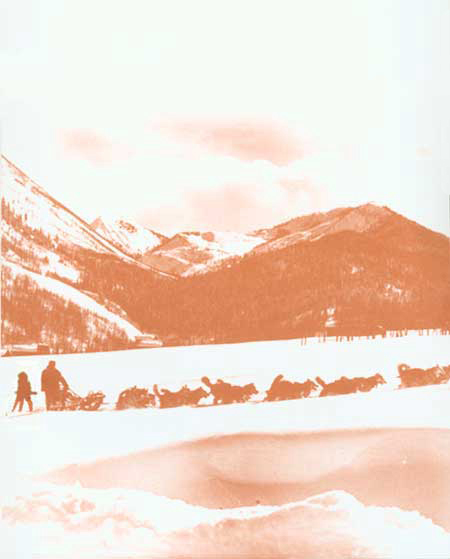|
MEANINGFUL INTERPRETATION The Interpretive Equation |

|
|
"THE TRUE TEACHER DEFENDS HIS PUPILS AGAINST HIS OWN PERSONAL INFLUENCE." —Amos Bronson Alcott
|
The Interpretive Equation
MORE THAN THE SUM OF ITS PARTS
BECKY LACOME
If you take an interpretive program or product apart to find out what it's made of — what its components are — what would you find? Some might argue that too much of this kind of analysis is detrimental to the creative/artistic process — or that interpretation is too subjective to be dissected or quantified.
If this is true, then the only interpreters who can truly be effective are those with the innate ability to let the appropriate type and amount of creativity just flow forth. Would these "naturals" be able to articulate what makes their efforts successful?
Freeman Tilden suggested that interpretation IS an art, but like all art, it is to some degree teachable. How do we help others learn the craft, if we can't analyze and articulate the elements of success? How can we evaluate our own effectiveness — the elements/techniques that work and the ones that don't? How can we make a case for managers to invest in what we do?
The Interpretive Equation can help!
I have always been math-challenged. So when someone showed me the Interpretive Equation for the first time, I felt a headache coming on. But the analogy of the Equation as a "tool" in the interpreter's "tool box" piqued my interest. I thought that once I learned to use it, the Equation might prove valuable.
The Equation is a metaphor — an analogy for understanding interpretation.
Thankfully, it's really not math! Like all good tools, the Equation can be used in different ways — for self-evaluation, for training and coaching other interpreters, and for explaining how interpretation works to managers, maintenance, and resource management staff. I can use it to identify areas where I need additional training and knowledge, or where my employees have developmental needs. And it's extremely useful for interpretive planning in the developmental stages of any kind of new product — programs, written products, exhibits and other media. Or it can be used on existing products to see how they "measure up" (if I'm not afraid to take an honest look that may reveal the weaknesses and imbalance in my work).
There's more! Although the Interpretive Equation provides one way to identify the elements of successful interpretation, its greatest strength may be that it can help us visualize the relationship between these elements. Everyone may not find it useful. But I find it an extremely helpful way to visualize, analyze, articulate, and balance the substance of each interpretive program and product. For me, the Equation adds up to something much more important than the sum of its parts.
(KR + KA) x AT = IO
KR — Knowledge of the Resource
KA — Knowledge of the Audience
AT — Appropriate Techniques
IO — Interpretive Opportunity
KR — Knowledge of the Resource
Knowledge is the foundation for everything we do as interpreters. We are responsible for developing and maintaining a thorough and accurate knowledge base supported by personal research, rather than what we hear from other interpreters. It is important to to have a keen personal interest in knowledge about and understanding of the resource.
Full knowledge of the story begins with a comprehensive collection of facts and information relevant to the resource. This includes an accurate understanding of both current and past theories and interpretations. Knowledge of the Resource also includes the history of the resource as a resource (administrative and resource management history), information about past and present uses and issues, current conditions, and all the reasons why it has been deemed important and relevant enough to be preserved. Since interpretations of what constitutes significance can change over time, we should have knowledge of the historical attitudes toward the resource, and a sense of the continuum of our site's natural and cultural history.
|
KR = Knowledge of Resource
|
But our KR must go beyond the "facts." While information is essential to interpretation, information alone is not interpretation. An interpreter's knowledge base is not complete without a comprehensive awareness of, and ability to articulate, the many meanings and values that make the resource relevant to a diverse public — the tangible/intangible links and universal concepts. What meanings do the facts represent and which meanings are the most universal, understood in some way by the broadest audience? Without this level of knowledge, our interpretation will be "sterile" and one-dimensional. Interpreters should be able to articulate numerous potential links between each primary tangible resource at their site, and the intangible meanings it represents. How many "links" can you identify at your site?
Acquiring this knowledge involves first discovering our own meanings, making our own personal connections — the reasons why we value our place. Then we must open our minds and hearts to identify and understand the multiple meanings or perspectives of others, even when they radically differ from our own. Interpretation that appropriately acknowledges multiple perspectives creates balance and depth, and fosters dialogue, rather than presenting a single "truth."
KA - Knowledge of the Audience
Comprehensive KR does little good without equal Knowledge of the Audience. A resource meaning that is not relevant to the audience does not make connections — as Freeman Tilden suggests, it's "sterile."
The foundation for KA is visitation and demographic information about past and current visitors that has been collected, and sometimes interpreted, through statistical reports and studies. Where do our audiences come from? How old are they? How long do they stay? What park activities do they participate in? But this is just a starting point.
For our interpretive programming to be most relevant, we must also know about their group identity, culture, ethnicity, learning styles and motivation for coming. What are their expectations and interests? What existing meanings, interpretations and attitudes do they bring to the resource? Obviously we can't know everything about each individual visitor. But we can carefully begin to make some generalizations to help us meet their needs and expectations and to offer multiple opportunities for finding personal connections with the meanings of site resources.
|
KA = Knowledge of the Audience
|
It is important to understand and respect the reasons why visitors come to our places, and to meet them "where they are" in their understanding of the value of the resource. They would not have come if there weren't something about the place that already had some value to them — recreational, educational or inspirational. An effective KA enables us to recognize when to let the visitor and the resource interact on their own, and when and where it is appropriate to use interpretation to help them discover new or renewed meanings in the resource. An effective KA also enables us to use our KR in the most appropriate and meaningful ways, rather than overwhelm visitors with everything we know about the resource.
A good KA requires more than just lip service to truly begin to "know" our audiences, and to learn about and reach out to new or non-traditional audiences. If we care about who our audiences are, we can help them care about park resources so that they may want to help care for them.

AT - Appropriate Technique
Although knowledge of our resources and audiences is the foundation, it will fail if it is not selected and applied in an appropriate and compelling way. For me, the "technique" of interpretation is the fun and creative part. It's where I dig into my "tool box" to creatively and provocatively attempt to connect the meanings of the resource (KR) to the interests/experience of my audience (KA).
First and foremost, the selection of techniques should always be based on specific program/product objectives that support the larger resource interpretive themes, goals, objectives and or mission of the site (if such planning documents exist).
Working from this foundation, the selection of an appropriate medium or vehicle is based on knowledge of the strengths and weaknesses of each approach. This includes having the necessary skills to execute the chosen approach effectively. It also involves selecting ways to actively and/or passively involve the audience. Organization of the material is also a matter of creative technique. Crafting a compelling theme or central idea that ties all the information and methods together will provide a focus for the audience connecting to the meanings of the resource. And, of course, technique also involves the interpreter's style, attitudes and enthusiasm.
|
AT = Appropriate Technique
|
With so much involved in constructing/creating an interpretive program or product, it is easy to forget to "reality check." Have you ever attended an interpretive program as a visitor and cringed at some inappropriate aspect? An audience of mostly children gets a lecture on plate tectonics, or a group of older adults is visibly embarrassed as the interpreter coerces them to dress up in bat costumes and pretend to fly around the campfire catching prey. The interpreter may get an "A" for enthusiasm, but the style and approach of the program are all wrong. Appropriate technique means that the interpreter has not gotten carried away with the "creative" part and forgotten to apply technique against the canvas of KA and KR. This is perhaps where many of us get the Interpretive Equation seriously out of balance.
Technique is appropriate only if it shows care and respect for both the resource and the audience by applying a thorough knowledge of both — (KR + KA) x AT — throughout the entire process of crafting and delivering a program or product. In fact, the most effective interpreters learn to gauge their audiences as they go along, and have contingency plans to adjust if necessary. This means not being so enamored by the techniques we've chosen that we lose our sensitivity to audience response.
"Appropriate" also means knowing when to let the resource speak for itself. Every program/product doesn't need to be a maximum intensity connection experience. The most appropriate techniques are those that provide effective access to resource meanings. Sometimes a subtle or simple approach, understatement, or even silence, can have significant intellectual and emotional impact. It is also important to remember that not all visitors require an intensive experience in order to find their own connections to resource meanings.
|
Involvement Techniques Passive Involvement: promotes attentiveness, thinking, feeling (emotional involvement), and passive sensory involvement (watching and hearing) Word pictures Storytelling Relating concepts to visitor experience Variation of voice and volume Role playing/dramatic interpretation Rhetorical or thought provoking questions Demonstration Active Involvement: promotes physical action and movement, looking (as opposed to watching), active listening (as opposed to hearing), and other sensory involvement (tasting, smelling, touching) Demonstrations with visitor participation Questions that require a verbal answer Problem-solving Games, scavenger hunts Props that visitors can handle Assignments: i.e. listing, looking/finding, counting, writing, making something, drawing Sensory suggestions i.e. smelling, tasting, touching, active listening Team activities/assignments Brainstorming |
IO - Interpretive Opportunity
When the Interpretive Equation is appropriately applied, an effective Interpretive Opportunity is created for a meaningful connection between audience and resource. The connection occurs within the individual audience member, who is in control of his or her own mind and emotions. The interpreter's job is to offer the opportunity, which the audience may or may not take. Individual visitors have subjective perspectives — based on personal background, experience and circumstances — that may or may not prompt them to take advantage of the opportunity provided.
However, the more effective the application of the KR, KA and AT, the better the probability for the IO to be irresistible!
For the audience to make personal intellectual and emotional connections to the meaning of the resource, the program/product should be constructed of many smaller opportunities. Such a product has the broadest appeal. Think of the a program as a dessert tray. It's carefully designed and arranged to include a treat to appeal to everyone, from the light and fruity sorbet to the deep and decadent "death by chocolate." The tray is the Interpretive Opportunity or product composed of individual opportunities that work together to create a larger set of favorable circumstances.
From a practical, working perspective, these smaller opportunities for emotional or intellectual connections to the meanings of the resource are the compellingly developed and presented tangible/intangible links. An effectively developed tangible/intangible link integrates and balances the KR, KA, and AT.
The careful selection of the link represents the interpreter's knowledge of both the audience and the resource. The technique/method for presenting the link is designed to make it relevant, meaningful and memorable for that particular audience.
An interpretive program or product involves creating a series or structure of these opportunities and creatively weaving them together to make a point — or speak to a larger meaning or issue, that is relevant to both the resource and the audience.
More Than the Sum of Its Parts — Desired Outcomes
By setting up the potential for the audiences' personal connections, an Interpretive Opportunity becomes the vehicle for the ultimate goal of interpretation. A "connection" can mean new or renewed insight, feelings, perception, revelation or discovery regarding a meaning of the resource that has some personal relevance to the visitor. Whenever a visitor reacts positively to an interpretive opportunity, and makes a personal connection, that visitor has likely come to care (a little or a lot, new care or more care, on an intellectual and/or emotional level) about the resource being interpreted. A raised level of care is the result of connections made.
"Care" about the resource may be a mind set, memory or attitude, or it may result in actual behavior to help care for the resource in some way. Because the connection happens within the visitor, and the reaction may or may not be immediately discernible, the most effective interpretive efforts should raise the level of personal meaning the resource has for the visitor, rather than "preaching" stewardship. This results in the increasing care that flows naturally for each visitor, without laying a stewardship "guilt trip" on the unsuspecting audience, or imposing the interpreter's or the agency's values. Bottom line: visitors will only care for what they first come to care about.
The desire to help visitors care about the resource represents our best intentions. But isn't the attainment of this desired interpretive outcome merely guesswork without evaluation? Do visitors actually care more about the resource after attending my program or reading my article in the park newspaper? A formal visitor study (i.e. focus groups, entrance/exit interviews) is the only way to know with some certainty. However, the beauty of the Interpretive Equation is the amount of control it gives the interpreter in planning and designing a program or product to have the maximum potential effectiveness.
I can plan and orchestrate the Interpretive Opportunities I want to present based on reliable principles, and continue to fine-tune the program as my knowledge and experience with different audiences deepens. If something in the program doesn't seem to be working the way I intended, I can apply the Equation to begin to analyze where there is imbalance. (I have good, creative techniques but are they appropriate for this audience? Do I have too much in-depth information for this audience and/or this delivery venue?) The ability to articulate and analyze the elements of success using the Equation can help eliminate some of the "guesswork." It also allows me to increase my interpretive effectiveness in more specific and proactive ways by using my own informal evaluation — observing and listening to visitor response.
|
Balancing the Interpretive Equation KR = Balanced KR doesn't inundate visitors with an overload of "just the facts"; nor does it put the visitor in a passive role by telling them what they should think. Rather it provides balanced amounts and types of accurate information that provoke people to actively explore meanings, issues and ideas for themselves. KA = Balanced KA recognizes and respects the diverse levels of interest, motivation, and understanding of park visitors and constituents; it incorporates a balance of multiple perspectives that encourages people to think about and develop their own stewardship values. AT = Balanced AT employs a variety of appropriate media and techniques that provides access to resource meanings, and encourages the greatest number of people to become personally involved with park resources. IO = The more balanced the application of the KR, KA and AT, the more favorable become the set of circumstances for the Interpretive Opportunity to have broad appeal — to encourage the most visitors to make their own intellectual and emotional connections to the meanings and significance of park resources. We never know for sure if an interpretive product will be effective. But applying the Interpretive Equation makes it a "calculated" risk, rather than a shot in the dark. In this way, the sum total — the value — of the Interpretive Equation goes far beyond a catchy way to remember the elements of interpretation. It can become the great "equalizer" in the application and creativity toward the greater goal of responsibility and respectfully helping others to care about park resources. |

©2003 Eastern National. Eastern National provides quality
educational products and services to America's national
parks and other public trusts.
ISBN 1-59091-019-2
meaningful_interpretation/mi3.htm
Last Updated: 29-May-2008
Meaningful Interpretation
©2003, Eastern National
All rights reserved by Eastern National. Material from this electronic edition published by Eastern National may not be reproduced in any manner without the written consent of Eastern National.